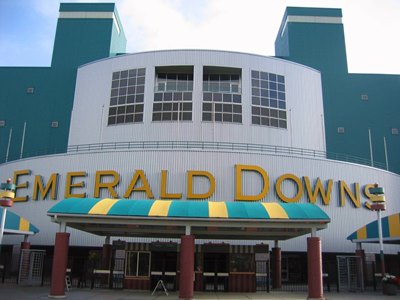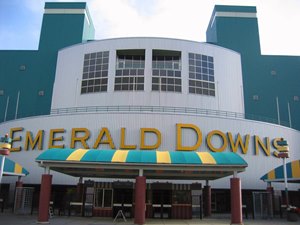Analysis: Optimizing Schedules Pays off for Tracks


In a year that televised broadcasts became more important than ever for racing as COVID-19 protocols kept fans away from the tracks, TVG and its track partners saw major gains from coordinating racing schedules.
TVG forwarded BloodHorse data that suggests benefits to handle following efforts to coordinate racing schedules this year at Lone Star Park, Indiana Grand, Canterbury Park, and Emerald Downs. It's important to note that while some tracks that were able to continue racing at a time when others had to halt their racing schedules saw massive gains in handle, these four tracks were not among those that capitalized by such a shortage of betting options. Their meets begin weeks just after that period.
The coordination of schedules allowed for dramatically improved exposure of the tracks' races on TVG. In 2020 all four tracks saw 91% or more of their races televised on the racing channel, as opposed to about half their races in 2019 (see chart below, which does not count races shown on TVG2).

In looking at numbers it's important to remember that 2020 was an unprecedented year. Consider that on March 14, there were 23 tracks across North America that offered racing. Three Saturdays later, just six tracks presented cards. But in this challenging year, racing did see innovation and cooperation.
As outlined earlier, these four tracks started their meets as racing began to come back to life after the onset of the pandemic. Track handle data suggests this cooperation on scheduling—targeting downtimes and having their signals work together—paid off in a big way at the four tracks. Lone Star Park reported record average daily handle of $2.1 million as average daily all-sources handle was up 131% from 2019. Indiana Grand saw a 31% bump in handle for its meet despite racing 26 fewer days in 2020.
At Canterbury Park, off-track wagering more than doubled, up 116% to $64.7 million as the track reported record total handle for $68,388,502 for 53 days; shattering the previous mark of $48,142,704 set over 66 race days in 2018. Emerald Downs reported a 61% spike in average daily handle at its meet compared with 2019.
TVG said it worked with the tracks to craft the best race schedules in terms of days of the week and post times to optimize handle. Also, keeping post times off the top of one another provides bettors the opportunity to play multiple tracks.
"Scheduling race days and post times is a balancing act," said Tom Cassidy, senior manager of industry relations for TVG. "TVG has been working with partner tracks for several years to help them take advantage of times when there is less competition and more opportunity to grow handle. Rationalizing the racing schedule ultimately benefits everyone, racing fans, our partner tracks, and their horsemen."
The race days and start times allowed the tracks to work with TVG toward having the signals complement one another.
Indiana Grand featured a Monday-Thursday typical schedule with a 2:20 post time (all times ET) when it offered racing from June 15-Nov. 19. Lone Star Park (May 22-Aug 12; Sept. 4-Nov. 28) raced Monday-Wednesday with a first race post time of 2:35.
Then in the evening, Canterbury Park (June 10-Sept. 17) offered a Monday-Thursday schedule with first post time of 5:30 while Emerald Downs (June 24-Oct. 29), which typically raced Wednesday-Thursday, would start at 8 p.m.
All of these tracks found success while moving away from Saturday racing, where they would compete against signals from larger tracks. When racing returns to normal, tracks will have to weigh their scheduling decisions as Saturdays typically bring in the largest on-track crowds.
While TVG likely was motivated, at least in part, to forward these numbers to BloodHorse to promote what the racing channel and advance-deposit wagering site can do for tracks in terms of handle, there are compelling numbers to consider as racing moves forward and tries to build loyalty from some of the new fans it cultivated in 2020.
There were likely some other factors contributing to these spikes in handle, such as other major sports facing their own delays. This may have sent those sports fans and gamblers searching for alternatives.
It's also fair to say that by working together with TVG on their schedules, these tracks were poised to take full advantage of that suddenly available market. Continuing with those lessons in the years ahead makes sense as the sport needs to maximize its racing product, especially considering the continued decline in foal crops and starts. With the added reliance on ADW handle in 2020, and that trend continuing on some level going forward, the industry also should re-examine its business model as the bulk of such handle is split three ways—tracks, purses, ADW—as opposed to the two-way split of track-purses for on-track wagers (live or simulcast) to ensure the splits are working for all involved.
In 2020 TVG's experience wasn't the only positive example of tracks working together to maximize their schedules. The New York Racing Association often featured other tracks—Oaklawn Park, Churchill Downs, Tampa Bay Downs, and others—during its television broadcasts on the Fox Sports platforms this year. The well-coordinated scheduling of those signals allowed viewers of those programs to wager on the multiple tracks presented.
The Jockey Club has pushed for such schedule coordination for years. At The Jockey Club's 2017 Round Table Conference on Matters Pertaining to Racing in Saratoga Springs, N.Y., McKinsey & Company partner Ben Vonwiller said tracks could use big data to develop better-coordinated racing schedules. He projected such optimization in signals could generate an additional $400 million in handle.
McKinsey: Better Scheduling Would Add Handle
The message seems to be getting out as even Gulfstream Park, notorious in recent years for dragging its post time as horses paraded—seemingly endlessly—on the track with "0 minutes to post," has returned to starting its races as scheduled. That should better allow other tracks to properly stagger and adjust their post times to not race in competition with Gulfstream.
Gulfstream Park Ends Its Post-Time Dra
TVG is no stranger to such efforts. Two years ago BloodHorse documented how the racing channel had worked with night tracks to coordinate schedules to provide the opportunity for horseplayers who wished to wager on multiple tracks.
Nighttime Tracks Work Together on Post Times
On Dec. 18 TVG forwarded some comments it collected from racing executives at Canterbury, Emerald, Indiana Grand, and Lone Star Park. Again, these are comments were collected by TVG, but I think they're worth sharing as they outline the importance of having races on television as well as at the best possible times to maximize returns.
"With limited attendance (in 2020) we knew it would be challenging to focus as much on the on-track experience as we would traditionally," said Canterbury vice president of racing Andrew Offerman. "We worked with TVG on what days would put us in the best position to maximize visibility and handle. The results started strong and continued that way the entirety of our 53-day meet."
Offerman said the increased presence on TVG—up from 46% of its races in 2019 to 97% in 2020—was immediately noticeable.
"We were able to tell in real-time that when more of our races were on TVG. We might have averaged about a third of our races in prior years but this year the number was over 90%. The impact was immediate," Offerman said. "Our off-track handle ended up being up about 170% per race. Handle from TVG and other ADW business was up over 200% throughout the meet. TVG was easily the number one source for our 2020 handle."
Eric Halstrom, vice president and general manager of racing at Indiana Grand, noted that with restrictions on on-track fans, the track brainstormed new ideas.
"We knew our on-track business wouldn't necessarily justify us sticking to our usual schedule so we worked with TVG to see where we could maximize the value of being on the network," Halstrom said. "It wasn't just days of the week, we worked with TVG to ensure we weren't right on top of other tracks that were operating on the same days we were. TVG was a very big part of why we had such a good year. The coverage helped drive handle from all sources. We know our fans watch TVG but they may have multiple wagering accounts, so the handle comes in from other platforms, too."
Brandon Leigh, director of marketing and player development at Lone Star Park, said tracks need to look at maximizing their signals.
"It makes a lot of sense for the whole industry to get a more equitable distribution of simulcast product. You definitely notice the difference from when there are a lot of signals to when there are fewer," Leigh said. "We talked with TVG about what the options were for both days and times and it fell into place naturally. We had the benefit of an increase in purses and an increase in field size as well."
Emerald Downs president Phil Ziegler also noted the track worked with TVG to set post times that would be most appealing to fans around the country.
